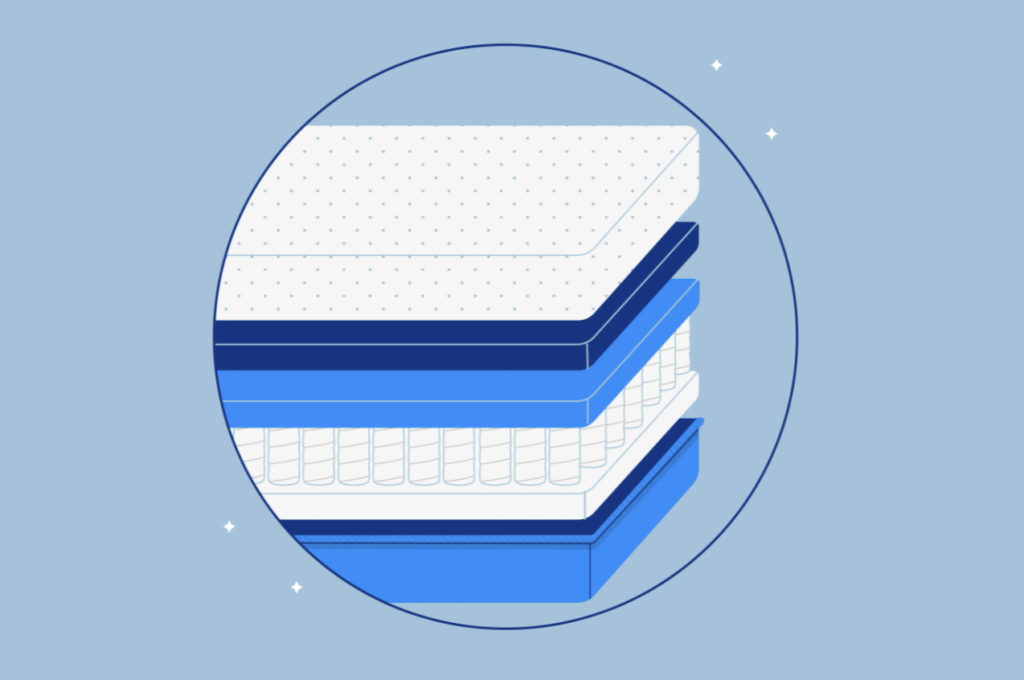Mattresses are typically layered. While each layer has a specific function, they all work in tandem to give a mattress its overall feel.
Comfort layers are the topmost sections of a mattress, and they significantly impact how a sleeper experiences their bed. If a mattress has more than one comfort layer, they’re collectively referred to as a comfort system.
Both material variety and quality dictate how well a mattress performs across categories. Construction methods also influence mattress pricing. Knowing the potential benefits and drawbacks of different materials and composition techniques can help you pick the most appropriate mattress.
What Are Mattress Comfort Layers?
As the name suggests, comfort layers are designed to make the sleeping experience as enjoyable as possible. Softer, close-conforming materials cradle the body and redistribute pressure, while firmer options limit sinkage to promote proper spinal alignment.
Beyond adding cushioning and pressure relief, comfort systems can isolate motion, muffle noise, and regulate temperature. They also serve as a necessary barrier between your body and the firmer support system. However, their overall performance depends on the materials, firmness, and thickness.
Mattress Comfort Layer Materials
Comfort layers can be made from an array of materials, but most fall into one of six main varieties: memory foam, polyfoam, latex, natural fiber, minicoils or nanocoils, and buckling column gel. Each material feels and performs differently, which greatly impacts the overall sleep experience.
Memory Foam
Memory foam is a type of polyfoam that was designed by NASA engineers before becoming widely available for commercial use. Also known as viscoelastic foam, memory foam is used almost exclusively in comfort and transition layers because of its conforming nature. Some comfort systems are made entirely of memory foam, while others also add layers of polyfoam, latex, or mincoils.
Memory foam softens in the presence of heat, giving it its characteristic body-hugging sensation and allowing it to cradle pressure points around the shoulders, hips, and lower back. Memory foam cools and returns to its original form when the sleeper leaves the bed.
In addition to providing pressure relief, memory foam also absorbs movement and noise well, making it an excellent choice for couples.
A possible disadvantage of memory foam’s deep contouring is that movement may feel restricted. Traditional memory foam also tends to retain heat because of its denser composition and close hug.
Because many people sleep hot, companies have developed various cooling technologies intended to improve temperature neutrality. One of the most popular types is gel memory foam, which incorporates gel infusions engineered to dissipate excess heat. Infusions of green tea, graphite, copper, and/or bamboo are designed for similar purposes. Phase change surface infusions crafted to wick away heat are also increasingly common.
Manufacturing methods can also affect the feel of memory foam. Varieties with open-cell structures leave extra spaces within the foam, making the material softer and more breathable. In contrast, closed-cell memory foam tends to be firmer and more prone to heat retention.
Memory foam is measured in pounds per cubic foot (PCF), a measure of density that is an important indicator of certain performance factors, like contouring, motion isolation, responsiveness, and temperature control.
Polyfoam
Polyfoam is short for polyurethane foam. This synthetic material traditionally uses compounds derived from petrochemicals. Most comfort systems formerly consisted of polyfoam, but more and more companies are turning to memory foam and/or latex.
Unlike memory foam, which has very specific qualities, the performance of polyfoam can vary greatly depending on the production method. This variability makes the material common across all mattress layers.
Two main types of polyfoam are popular for comfort layers: uniform and convoluted. Uniform polyfoam is typically used in quilting and middle upholstery because it has a flat and even surface. Convoluted polyfoam, or egg crate foam, has ridges and is occasionally used in transitional layers. In general, though, convoluted polyfoam is more often used in mattress toppers than in mattresses themselves.
Polyfoam is generally not considered a top-of-the-line material for comfort layers because of its relatively low density. It doesn’t typically contour as deeply as memory foam or latex, and its lower density also means that it may degrade more quickly. As a result, mattresses made with polyfoam comfort layers are usually less expensive than those made with denser alternatives.
Like memory foam, polyfoam is traditionally measured in PCF. The three polyfoam grades are high-resiliency (HR), high-density (HD), and conventional. The compression modulus range, which is the ratio of stress-to-strain, may also be worth noting.
Latex
Natural latex is derived from the sap of rubber trees, while synthetic latex uses chemicals derived from petroleum. Blended options are also available. This versatile material known for its durability is found in comfort systems, transitional layers, and support cores.
There are two main methods for producing latex: Dunlop and Talalay. The Dunlop process generates a denser latex that can be used in comfort layers, transitional layers, and support cores. Talalay latex, on the other hand, has a fluffier, more uniform texture that makes it more suitable for comfort and transitional layers.
Because it has lower point elasticity than memory foam, latex spreads the compression over a wider area, creating more of a floating sensation than a hug. This limited sinkage paired with its more breathable composition typically makes latex cooler than memory foam. Latex also has notable bounce, which makes it conducive to sex and movement in general. The tradeoff of springiness, however, is often greater motion transfer.
To be classified as a latex mattress, a model must contain at least one latex comfort layer and a latex support core. A model labeled as natural latex may contain a small amount of synthetic latex. Certified organic latex must contain over 95% certified organic raw material.
Latex’s firmness is measured using indentation load deflection (ILD) rather than density.
Each type of comfort layer material has specific properties that affect how a mattress performs across a range of categories.


